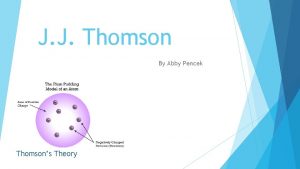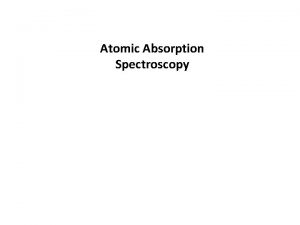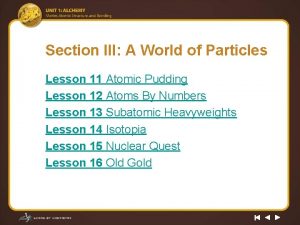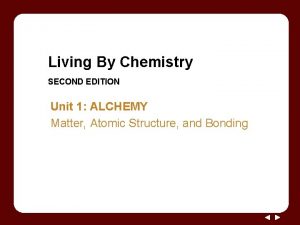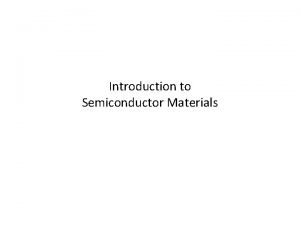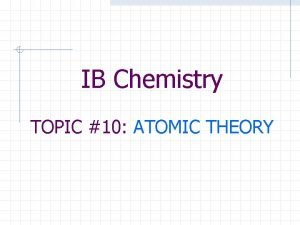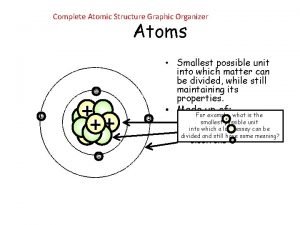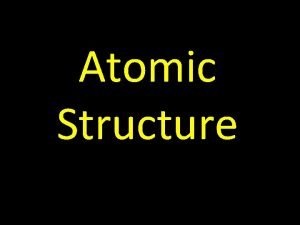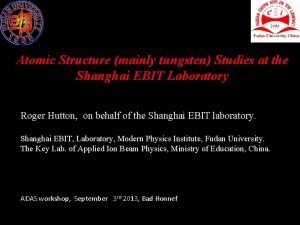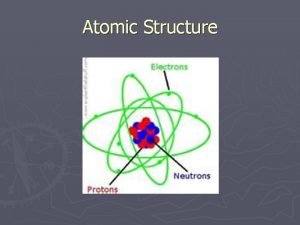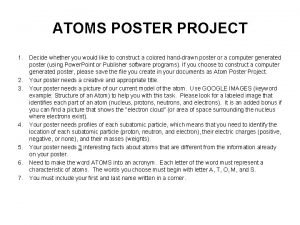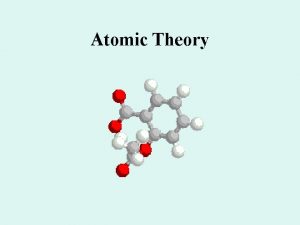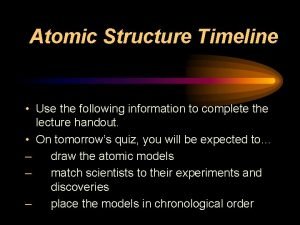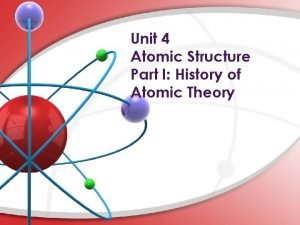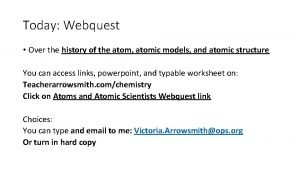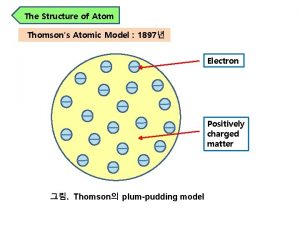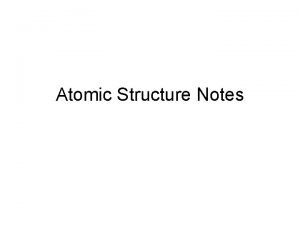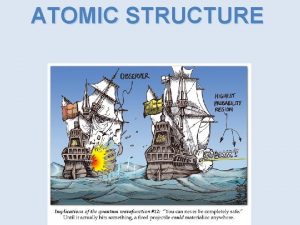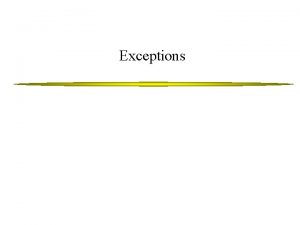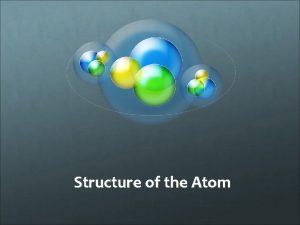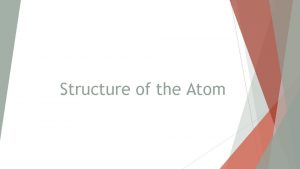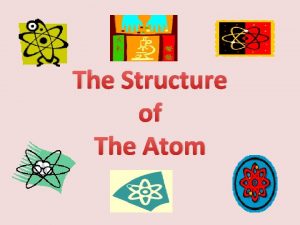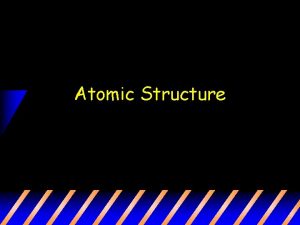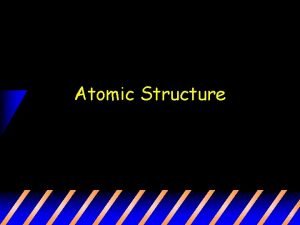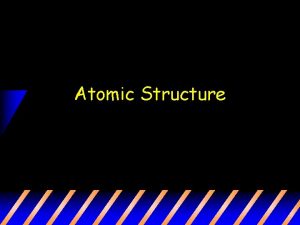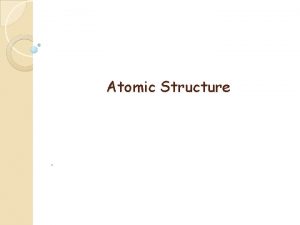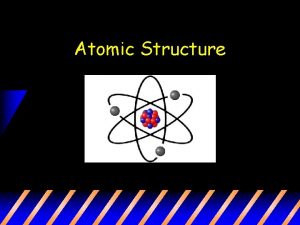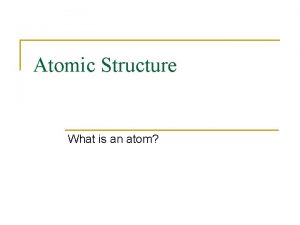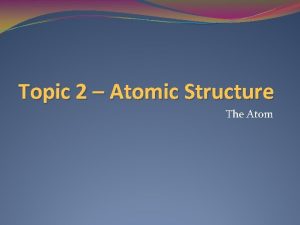Atomic structure try 1 Thomsons atom continued Schematic





























- Slides: 29


Atomic structure: try 1 –Thomson’s atom (continued) Schematic of Thomson’s critical experiments 1)Battery voltage tears something (e-) away from metal cathode 2) e- beam from cathode (- plate) accelerated towards (+) plate 3) Fields applied and results observed on `TV’ screen

Atomic structure: try 1 -Thomson’s atom (continued) Basic result of Thomson’s CRT experiments: All the materials subjected to high voltage in the tube vomited the same kind of `negative’ particles-dubbed the electron. It weighs 1/2000 of an H atom !!!! Thomson’s Conjecture from his CRT experiments If all matter has negative electrons, there must be a counterbalancing positive glue that sticks to and neutralizes the electrons’ negative charge (since matter is normally neutral).

Thomson `Plum Pudding’ Model of atom 1 1897 1 Alternative analogy for us Americans Electrons=chocolate chips Philosophical Magazine 44, 295 (1897) Dough=`positively charged matter’

Testing the plum pudding atom: Rutherford’s gold foil experiment (1910) (see also: page 52 of text) Ernst Rutherford Physical Laboratory Manchester University, UK Rutherford’s Gold foil apparatus* *Factoid: it’s really his students-Geiger and Marsden- who machine the device and do the measurements.

Atomic structure: testing Thomson’s Plum Pudding atomic model (continued) Schematic of Rutherford’s `gold foil’ apparatus • Alpha ( ) particles=He+ Microscope Rotated to detect scintillations Zn. S screen is a scintillating surface Gold Foil Experiment lore 1) Marie Curie supplied the radon = source. 2) It required ~ 1 hour sitting in absolute dark to condition eyes. 3) You could only observe scintillations for 1 -2 minutes before desensitizing.

Atomic structure: testing Thomson’s Plum Pudding Atomic Model(continued) Other Facts about the Gold Leaf Experiment rarely mentioned: • particles move crazy fast: velocity ~ 0. 1 c ~7*107 mph (can get to NYC from here in ~0. 01 sec) • particles are crazy overweight compared to the electrons (e-) in a gold atom: ~800 X heavier than all 79 e- in gold atom • The gold foil is crazy thin: ~ 8. 6*10 -6 cm thick (~1/3000 the thickness of cheap toilet paper )

Atomic structure: testing Thomson’s Plum Pudding Model (continued): Reminder of the Plum Pudding Model being tested

Given the preceding facts, predict how the particles will behave after striking the gold foil if the structure of gold is as described in Thomson’s Plum Pudding model. A. Bounce straight backwards off the foil like a baseball hitting a wall. B. Punch through the foil like it wasn’t there. C. Scatter off the foil randomly in all directions.

Plum Pudding model predicts the massive particles will pass ~un-deflected through gold foil made of diffuse matter particles • Rutherford’s observations mostly agree with above. • But sometimes a few curve off significantly… • And once and in a great while, one bounces back. ! Gold foil

Atomic structure: testing Thomson’s Plum Pudding Atomic Model(continued) Pictorial summary of results of gold foil experiment Seminal publication on results: Geiger H. & Marsden E. , On the Diffuse Reflectance of -Particles Proceedings of the Royal Society, Series A 82: 495– 500 (1909)

U-Tube version of Rutherford’s gold foil experiment run by Marsden and Geiger https: //www. youtube. com/watch? v=XBq. Hkraf 8 i. E

Atomic structure: testing Thomson’s Plum Pudding Atomic Model(continued) Rutherford’s famous `take’ on Marsden and Geiger’s results: Like firing a howitzer at tissue paper and having the shell bounce back !!” “

Which model below best explains the gold foil scattering data? A. Thin, dense electron ring around large, dense ball of positives. B. diffuse, continuous ball of electrons around tiny, dense ball of positives. C. Inner thin, dense positive ring surrounded by outer thin, dense electron ring.

Atomic structure: Rutherford’s Atomic Model Rutherford’s Atom: 1911 The Second Experimentally-Based Model of the Atom Electrons in diffuse cloud around tiny (but massive) positive charged nucleus. E. Rutherford, F. R. S. The Scattering of α and β Particles by Matter and the Structure of the Atom Philosophical Magazine Series 6, vol. 21, p. 669 -688 (1911)

Dimensions of Rutherford atomic model* *derived from statistics of gold leaf scattering experiment • Nuclear radius ~10 -15 meters • Electronic cloud radius ~ 10 -10 meters • Electronic radius/Nuclear radius ~ 10+5 Masses of subatomic pieces** Subatomic piece Mass (g) proton neutron electron 1. 67*10 -30 9. 11*10 -34 Relative mass 1 1 0. 0005 ** from J. Aston development of mass spectroscopy at Cavendish Labs (w/Rutherford as its’ new Director)

Atom dimensions in familiar terms…. from first week Metaphor 1 Electrons start here (~2. 4 miles past cheap seats) 3” Baseball as nucleus Old Yankee Stadium, the PS: Yanks rule Boston drools

Nucleus(+) ~ dimension of Rutherford’s electronic cloud (-) (2. 4 mile radius from baseball nucleus)

Atom dimensions in familiar terms Example 2 U-Do-It • Super Target store in Omaha, Neb. , is the nucleus • Assume the radius of the store is 75 m ~ 0. 05 miles. • Assume electronic cloud is 100, 000 X larger in diameter

Atom dimensions in familiar terms… U-Do-it Example 2: where is electron cloud? Chicago NYC 300 800 Nucleus= Super Target store in Omaha Paris ~5000 Beijing 12, 000

Which city best defines the boundary of Rutherford’s electron cloud if a Super Target store in Omaha is the nucleus ? A. Chicago: 3*102 mi away B. NYC: 8*102 mi away C. Paris: 5*103 mi away D. Beijing 1. 2*104 mi away Store radius = 0. 05 mi Electron radius =100, 000 Nuclear radius

Paris Nucleus=Super Target store in Omaha

Chemical metaphor 3: Proton mass nuclear vs. electron mass Electron mass 1 running back ~ 2000 large eggs

Rutherford’s Atom by the numbers (continued) Atomic part Relative volume Nucleus 0. 00000001 Electrons 1 electron cloud is 99. 9999% of atomic volume but only 0. 5% of the mass

Chemical metaphor 4: volume comparison-nucleus vs. electron cloud Volume occupied by nucleus Volume occupied by electrons

1912: Rutherford ‘s atomic model rules Electrons (-) out here + Protons (+) and neutrons squeezed in here

But there are 2 BIG Problems with Rutherford’s model 1)Why don’t the p+ and e- attract and come together ? ? ? (or…why isn’t Earth the size of a golf ball? ) ? ? ?

Rutherford atom’s problems (continued) 2)Why doesn’t the sun show all colors (e. g. show white light) when telescopes record spectrum? Diffraction grating divides up light colors ? ? ? Why only few really strong lines

BIGGER third AN EVEN PROBLEM FOR RUTHERFORD’S LAB 3) The photoelectric effect problem and the trouble with theory of light Help!!!!
 Facts about jj thomson
Facts about jj thomson The structure of the atom section 2 defining the atom
The structure of the atom section 2 defining the atom Flame aas
Flame aas Is atomic mass and relative atomic mass the same
Is atomic mass and relative atomic mass the same Periodic trneds
Periodic trneds Atomic size trend
Atomic size trend O
O Difference between atomic number and atomic mass
Difference between atomic number and atomic mass Atomic number vs atomic radius
Atomic number vs atomic radius Atoms family atomic math challenge doc
Atoms family atomic math challenge doc Lesson 11 atomic pudding models of the atom
Lesson 11 atomic pudding models of the atom Atomic alchemy
Atomic alchemy Perkembangan teori atom modern
Perkembangan teori atom modern Atomic structure and properties ap chemistry
Atomic structure and properties ap chemistry Mass of protons neutrons electrons
Mass of protons neutrons electrons Atomic universe theory
Atomic universe theory Full bridge rectifier animation
Full bridge rectifier animation What is z in atomic structure
What is z in atomic structure First ionization energy of calcium
First ionization energy of calcium Subatomic particles graphic organizer
Subatomic particles graphic organizer Aristotle atomic
Aristotle atomic Z atomic symbol
Z atomic symbol Tungsten atomic structure
Tungsten atomic structure 460 bc atomic structure
460 bc atomic structure Atom poster project
Atom poster project Atoms graphic organizer
Atoms graphic organizer James chadwick atomic model
James chadwick atomic model Ap chemistry atomic structure and periodicity
Ap chemistry atomic structure and periodicity Unit 4 atomic structure
Unit 4 atomic structure History of the atom webquest
History of the atom webquest
